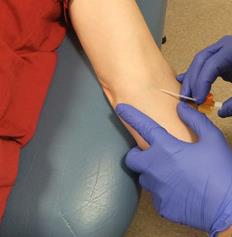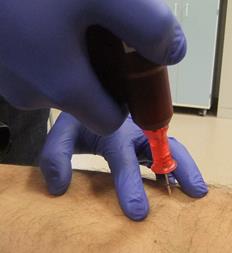Fluid therapy
The main stay of haemorrhagic shock is to control the haemorrhage and move the injured player to the nearest emergency department receiving trauma, once it is safe to do so with the appropriate personnel and equipment.
If time allows and this must not delay transfer, intravenous access should be gained. This is typically by placing two large bore intravenous 14-16ch gauge cannulas in each antecubital fossa. If this is not possible due to the injured player having shutdown peripheral circulation, it is worth considering using the external jugular vein. If this is not possible (if there is suspected cervical spine trauma) then access can be achieved by using the intra-osseous route. In civilian practice is this is through the anteromedial surface of the tibia two finger breadths below the tibial tuberosity or in the anterior aspect of the proximal humerus.

IV access with a large bore (14 ch) cannula via the the antecubital fossa

Interosseous access via placing an IO needle into the anteromedial surface of the tibia.
Fluid therapy is only given in the pre-hospital setting if the patient has lost their radial pulse or the systolic blood pressure is below 90 mmHg. Crystalloid fluid is administered in boluses of 250mls. It is essential that after the administration of each 250mls, the patient is reassessed to identify if the radial pulse as returned (or SBP >90mmHg). If this is the case then no more fluid should be administered unless the radial pulse is lost again (transient responder), or the SBP drops below 90mmHg.
Balanced resuscitation is key in managing an injured player in haemorrhagic shock. Following the above guidelines ensures fluid is only given when required to facilitate end organ perfusion. Giving large volumes of resuscitation fluids when not required e.g. radial pulse present or SBP>90mmhg potentially results in the first clot being blown off with the raised SBP and dilution of the remaining clotting factors and platelets. This may result in uncontrollable haemorrhage.
It is important, if an injured player has lost their radial pulse, to check a central pulse e.g. carotid, to check they have not gone into cardiac arrest - If this is the case CPR should be commenced immediately). In penetrating torso trauma, fluid management is guided by the presence or absence of the carotid pulse. Exceptions to the above guidance are; serious head injuries where fluid is given to maintain the cerebral perfusing pressure, in septic or anaphylactic shock, and in pregnant patients.
As with all injured or ill players regular reassessment is fundamental. This should be done at least every five minutes, on any sign of deterioration or after an intervention which includes in balanced fluid resuscitation after each 250mls bolus of fluid.